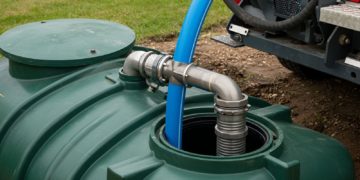In today’s rapidly evolving industrial landscape, the need for effective hazard mitigation has become paramount. The potential risks posed by industrial activities, ranging from chemical spills to machinery malfunctions, underscore the urgency of adopting proactive measures to safeguard the environment and human well-being. This introductory section delves into the significance of hazard mitigation in industrial settings and highlights the escalating demand for eco-friendly approaches to address these challenges.
In the following sections, we will delve deeper into the various sustainable approaches that can be adopted to mitigate hazards in industrial environments while minimising their ecological footprint. By integrating green infrastructure, renewable energy solutions, and responsible waste management, industries can pave the way for safer operations that align with environmental preservation and resource efficiency principles.
Importance of Hazard Mitigation
Industrial environments are often characterised by intricate processes, machinery, and materials that inherently carry certain levels of risk. Unforeseen accidents can lead to dire consequences, including environmental contamination, damage to infrastructure, loss of life, and substantial economic repercussions. Hazard mitigation involves systematically identifying, assessing, and reducing potential risks, thereby minimising the likelihood and impact of such incidents. By implementing effective mitigation strategies, industries can protect their assets and workforce and demonstrate a commitment to responsible corporate practices.
Growing Need for Eco-Friendly Approaches
Hazard mitigation strategies have traditionally focused on containment, emergency response, and damage control, often neglecting the long-term ecological consequences. However, with increasing public awareness of environmental issues and regulatory pressures, there is a shifting paradigm towards eco-friendly hazard mitigation. The detrimental impacts of industrial accidents on ecosystems, air and water quality, and biodiversity have prompted industries to explore sustainable alternatives that reduce risks and promote environmental awareness. This evolving mindset reflects a broader societal transition towards embracing environmentally conscious practices and underscores the necessity of integrating sustainability into hazard mitigation strategies.
Sustainable Strategies for Industrial Hazard Mitigation
As industries recognise the imperative to mitigate hazards while minimising their environmental impact, various sustainable approaches have emerged. This section explores critical strategies that enable industrial hazard mitigation through eco-friendly practices.
Green Infrastructure Implementation
Green infrastructure includes integrating natural systems and processes into the built environment to provide multiple benefits, including hazard mitigation. In industrial settings, green infrastructure involves the creation of vegetated spaces, natural drainage systems, and biodiversity-rich areas that help absorb and manage various hazards. Examples include:
-
- We constructed wetlands for treating and filtering industrial runoff.
- Rooftop gardens and permeable pavements to manage stormwater and reduce flooding. Buffer zones of native vegetation to prevent chemical runoff and soil erosion.
- By incorporating green infrastructure, industries enhance hazard resilience and contribute to improved air quality, biodiversity conservation, and overall ecosystem health.
- Implementing COSHH training for workers safety and environmental well-being to deal hazards substances at workplaces.
Renewable Energy Integration
The introduction of renewable energy sources into industrial operations not only reduces carbon emissions but also enhances hazard mitigation capabilities. Renewable energy sources, such as solar panels, wind turbines, and hydropower systems, can generate critical safety systems and emergency response infrastructure power systems. Additionally, renewable energy installations can function independently of centralised power grids, ensuring uninterrupted operations during emergencies. This integration promotes sustainability while bolstering the capacity to respond effectively to hazardous incidents.
Pollution Prevention and Waste Management
Preventing pollution at its source is a fundamental aspect of sustainable hazard mitigation. Industries can adopt strategies to minimise the generation of hazardous waste and pollutants through process optimisation, material substitution, and efficient resource utilisation. Proper waste management practices, including recycling, treatment, and safe disposal, further reduce the potential for environmental contamination. By prioritising pollution prevention and responsible waste management, industries contribute to safer and cleaner operational environments.
Benefits and Challenges of Eco-Friendly Hazard Mitigation
Balancing the benefits and challenges of eco-friendly hazard mitigation is essential for industries seeking to establish a sustainable and resilient approach to risk management. The subsequent section will explore case studies and best practices that highlight successful implementations of these strategies in various industrial contexts.
Adopting eco-friendly hazard mitigation strategies in industrial environments brings forth a range of advantages and potential challenges. This section examines the multifaceted outcomes associated with these sustainable approaches.
Environmental Benefits
Eco-friendly hazard mitigation holds profound environmental advantages, fostering long-term sustainability and ecological well-being. Some vital environmental benefits include:
-
- Reduced Ecological Impact: Integrating green infrastructure and pollution prevention measures minimises ecosystem damage, mitigating the long-term ecological impact of industrial accidents.
- Preserved Biodiversity: By protecting natural habitats and promoting native vegetation, industries contribute to conserving local flora and fauna.
- Cleaner Air and Water: Sustainable practices lower emissions and decrease pollution, improving air and water quality in and around industrial zones.
- Climate Resilience: Renewable energy adoption reduces greenhouse gas emissions, enhancing climate resilience and contributing to global efforts to combat climate change.
Economic Advantages
Eco-friendly hazard mitigation can yield significant economic benefits for industries and society at large:
-
- Cost Savings: Long-term cost savings result from reduced waste management expenses, lower energy consumption, and minimised liability for potential accidents.
- Enhanced Reputation: Industries prioritising sustainability and responsible practices can bolster their reputation, attracting environmentally conscious consumers and investors.
- Regulatory Compliance: Adopting eco-friendly practices aligns with increasingly stringent environmental regulations, reducing the risk of fines and legal consequences.
Technical and Implementation Challenges
Despite the considerable advantages, eco-friendly hazard mitigation approaches also present particular challenges:
-
- Initial Investment: Implementing green infrastructure and renewable energy systems may require significant upfront investments that could deter some industries.
- Technical Expertise: Integrating renewable energy and advanced waste management technologies demands specialised knowledge and expertise that might be limited.
- Adaptation and Scale: Adapting existing infrastructure to accommodate eco-friendly strategies can be complex, especially for large-scale industrial operations.
- Transition Period: The shift from traditional hazard mitigation methods to eco-friendly alternatives requires careful planning and gradual transition to ensure operational continuity.
Case Studies and Best Practices
Examining real-world case studies and best practices is instrumental in understanding the practical application and impact of eco-friendly hazard mitigation strategies in industrial settings. This section delves into successful implementations, lessons learned, and approaches that can be replicated across different industries.
Successful Implementations in Various Industries
-
- Chemical Manufacturing Facility: Explore how a chemical manufacturing plant integrated green infrastructure, such as constructed wetlands, to treat and purify wastewater before release. This approach reduced the risk of chemical contamination in nearby water bodies and promoted biodiversity.
- Automotive Manufacturing Plant: Discover how a car manufacturing facility incorporated solar panels to power critical safety systems, ensuring uninterrupted operations during power outages. This case study showcases the synergy between renewable energy integration and hazard mitigation.
- Food Processing Facility: Learn about a food processing plant implementing pollution prevention measures and optimising resource utilisation. The facility reduced the potential for hazardous materials to enter the environment by minimising waste generation and adopting efficient processes.
Lessons Learned and Replicable Approaches
-
- Integrated Design: Emphasise the importance of incorporating eco-friendly hazard mitigation strategies during the design phase of industrial facilities. This approach ensures seamless integration of green infrastructure and renewable energy solutions.
- Collaboration and Knowledge Sharing: Highlight the significance of collaboration between industries, academia, and regulatory bodies in developing and sharing best practices. Case studies reveal that knowledge exchange accelerates the adoption of sustainable hazard mitigation strategies.
- Adaptive Implementation: Discuss the need for flexibility and adaptability when implementing eco-friendly approaches. Industries should be prepared to refine strategies based on evolving technologies, regulations, and operational requirements.
- Investment and Return: Explore how industries can approach the initial investment required for sustainable hazard mitigation. Companies can justify their financial commitment by conducting thorough cost-benefit analyses and considering long-term savings.
Conclusion
The paradigm shift towards eco-friendly hazard mitigation in industrial environments marks a transformative approach that intertwines safety, sustainability, and responsibility. The urgency to safeguard human well-being and the domain has driven industries to adopt strategies that mitigate risks and contribute to broader ecological goals.
Industries are embracing innovative practices by recognising the importance of hazard mitigation and the growing need for sustainable solutions. Integrating green infrastructure, renewable energy, and pollution prevention measures minimises the impact of potential hazards and catalyses positive environmental change. These approaches underscore the interdependence of industrial progress and ecological preservation, emphasising that responsible risk management is linked to the health of our planet.
However, this journey is challenging. Balancing the initial investments, technical complexities, and adapting existing infrastructure requires careful consideration and collaboration. The lessons from successful case studies illuminate a path forward, where integrated design, collaborative partnerships, adaptability, and sound financial planning play pivotal roles in realising sustainable hazard mitigation.
In embracing these principles, industries enhance their resilience and contribute to the larger narrative of sustainable development. Hazard mitigation and ecological stewardship synergy exemplify a harmonious coexistence between industrial progress and environmental well-being, fostering a safer and more sustainable world for future generations.
David Prior
David Prior is the editor of Today News, responsible for the overall editorial strategy. He is an NCTJ-qualified journalist with over 20 years’ experience, and is also editor of the award-winning hyperlocal news title Altrincham Today. His LinkedIn profile is here.














































































